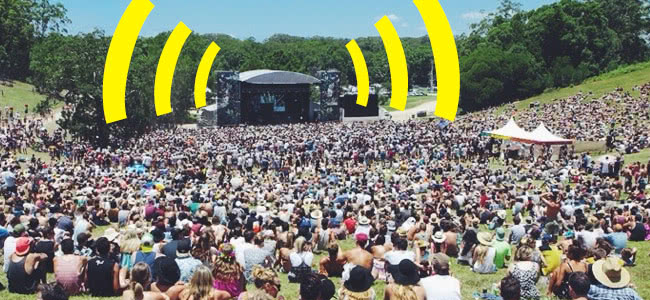Noise complaints have long been the scourge of the live music scene in Australia. This is certainly saying something, as it’s seen more than its fair share of problems in the past, including everything from scuffles with the liquor licensing board, to seemingly unending council troubles.
Music venues are on the front line when it comes to keeping both music fans and nearby residents happy, and sometimes neither party end up satisfied.
But music festivals also see their fair share of problems when it comes to sound, and North Byron Parklands, the home of Splendour In The Grass and the Byron Bay leg of Falls Festival, is currently engaged in a battle with nearby residents.
Last week we reported that Splendour In The Grass has copped its second fine in as many years for breaching noise limits during its 2015 event in June, a breach that has seen a local wildlife group call for the festival to be moved to a more suitable location.
The venue itself has admitted in its annual report released yesterday, which covers the 2015 Splendour In The Grass and the 2014/2015 Falls Festival, that “there is still more work do be done in the area of noise management, particularly with regards to lower frequency emissions.”
[include_post id=”467054″]
Compliance with strict noise restrictions is critical to both Splendour and Falls Festival continuing to use the site in the future, as the Department Of Planning and Environment has only approved a five-year trial at the site, due for review by 31st December 2017.
Noise restrictions already in place include:
1. Between 11am and midnight, noise level measured at sensitive receivers must not exceed background +10dBA
2. Between midnight and 2am, noise level measured outside the bedroom window(s) at sensitive receivers must not exceed background +5dBA
3. All stages must be shut down at midnight
4. Amplified music from bars, cafés and dance floor, are permitted to remain until 2am, subject to the stricter noise limit
5. All amplified music must cease at 2am
Organisers have done a remarkable job in reducing compliance issues across a number of key areas since first using the site for Splendour in 2013, including reducing phone calls to the community hotline regarding traffic problems to zero.
However, noise remains a crucial and lingering problem.
During Falls Festival 2014/2015, most breaches of noise requirements as measured by monitoring positions occurred between 9pm and midnight, although these exceedences were also observed on days where the event was not operating (29 December 2014 and 3 January 2015).
In total 22 noise complaints were made to the community hotline, with a higher number of these calls being recorded on New Years Day (Thursday Night).
[include_post id=”461476″]
Only seven of those callers requested that the noise be measured at their residence. Reviews of those results indicate recorded levels were either significantly influenced by ambient noise in the locality of the residence rather than Falls Festival or compliant with the noise limits.
An analysis of Splendour 2015 shows similar results, with recordings of breaches of noise limits occurring on days where the event was not even operating, suggesting that these exceedences are likely to be significantly influenced by local extraneous noise sources such as traffic.
Throughout the event a total of 127 complaints were received by the event community hotline, with 117 of those related to noise. In total, 98 different residences complained, with 18 residents lodging more than one complaint (ranging from 2 to 7 complaints).
Review of the data collated by the hotline operators indicated that noise related complaints were generally either described as the noise being too loud or specifically related to the low frequency noise content of the event noise.
Interestingly enough, low level frequencies are not covered by the festival site’s noise restrictions.
In addition, the current noise criteria are based on “backgroundCplus” limits that penalises events held during winter months.
During winter, background levels are up to 10dB lower than those recorded in summer. This seasonal differentiation in background levels has been repeatedly verified by way of multiple winter and summer background surveys undertaken by Parklands.
So while front of house music levels have been consistent between Falls Festival (summer event) and Splendour in the Grass (winter event) only Falls festival has been able to comply with the existing project approval’s noise limits, while Splendour in the Grass has not (due to the drop in ambient background noise levels).
As a result Splendour in the Grass, which occurs in winter, is effectively prescribed a significantly lower noise limit than the Falls Festival held in the summer, with no material scientific or environmental basis.
North Byron Parklands have since done their own assessment, and have applied to have low level frequency sounds included as part of their restrictions, in exchange for more flexibility on the higher frequency noise.
The modification is currently being processed by the DP&E.
In the meantime, both residents and festival organisers are left frustrated by regulations that although well-intended, fail to properly address the needs of both parties.
While residents should be able to get a good nights sleep, the festivals should not be unfairly burdened by factors that are simply outside of their own control.
Although it might make residents happy, festival punters are unlikely to be friendly to simply turning the music down to almost inaudible levels.
Moving forward, the concerns from residents will need to be carefully managed if there is to be a future of Splendour and Falls Festival at North Byron Parklands that keeps both the locals and festival punters happy.




































